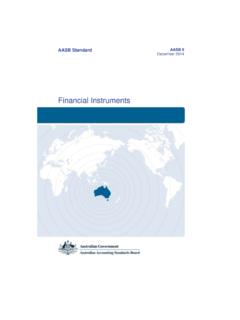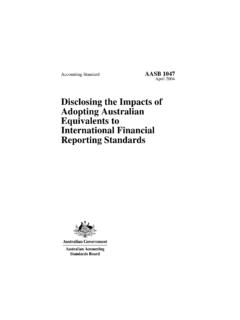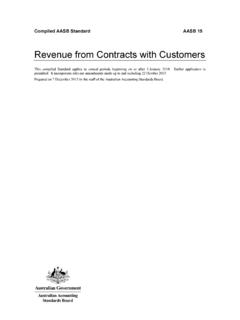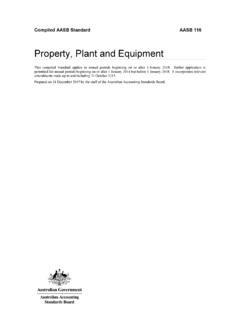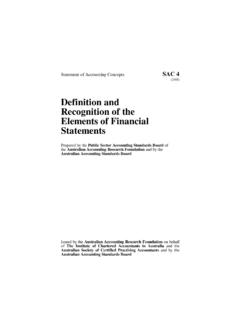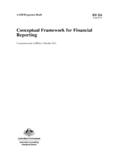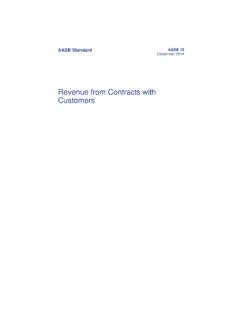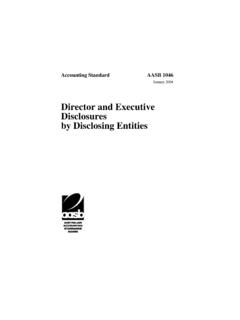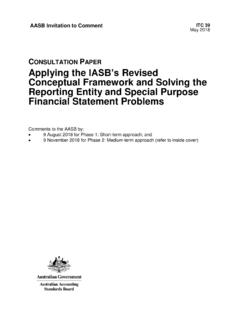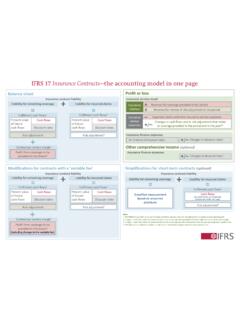Transcription of International Financial Reporting Standard IFRS 9
1 ifrs 9 IE ifrs Foundation International Financial Reporting Standard ifrs 9 Financial Instruments July 2014 ILLUSTRATIVE EXAMPLES International Financial Reporting standards together with their accompanying documents are issued by the ifrs Foundation. COPYRIGHT Copyright 2014 ifrs Foundation. Reproduction of this extract within Australia in unaltered form (retaining this notice) is permitted for non-commercial use subject to the inclusion of an acknowledgment of the ifrs Foundation s copyright. All other rights reserved. Requests and enquiries concerning reproduction and rights for commercial purposes within Australia or for any purpose outside Australia should be addressed to the ifrs Foundation at CONTENTS fromparagraphIFRS 9 Financial INSTRUMENTSILLUSTRATIVE EXAMPLESFINANCIAL LIABILITIES AT FAIR VALUE THROUGH PROFIT OR LOSSIE1 IMPAIRMENT (SECTION )ASSESSING SIGNIFICANT INCREASES IN CREDIT RISK SINCE INITIALRECOGNITIONIE6 Example 1 significant increase in credit riskIE7 Example 2 no significant increase in credit riskIE12 Example 3 highly collateralised Financial assetIE18 Example 4 public investment-grade bondIE24 Example 5 responsiveness to changes in credit riskIE29 Example 6 comparison to maximum initial credit riskIE40 Example 7 counterparty assessment of credit riskIE43 RECOGNITION AND MEASUREMENT OF EXPECTED CREDIT LOSSESIE48 Example 8 12-month expected credit loss measurement using an explicit probability of default approachIE49 Example 9 12 month expected credit loss measurement based on loss rateapproachIE53 Example 10 revolving credit facilitiesIE58 Example 11 modification of contractual cash flowsIE66 Example 12 provision matrixIE74 Example 13 debt instrument measured at fair value through othercomprehensive incomeIE78 Example 14
2 Interaction between the fair value through other comprehensiveincome measurement category and foreign currency denomination, fair valuehedge accounting and impairmentIE82 APPLICATION OF THE IMPAIRMENT REQUIREMENTS ON A REPORTINGDATERECLASSIFICATION OF Financial ASSETS (SECTION )IE103 Example 15 reclassification of Financial assetsIE104 HEDGE ACCOUNTING FOR AGGREGATED EXPOSURESIE115 Example 16 combined commodity price risk and foreign currency riskhedge (cash flow hedge/cash flow hedge combination)IE116 Example 17 combined interest rate risk and foreign currency risk hedge(fair value hedge/cash flow hedge combination)IE128 Example 18 combined interest rate risk and foreign currency risk hedge(cash flow hedge/fair value hedge combination)IE138 ifrs 9 IMPLEMENTATIONGUIDANCE ifrs Foundation3 ifrs 9 Financial InstrumentsIllustrative ExamplesThese examples accompany, but are not part of, ifrs liabilities at fair value through profit or lossIE1 The following example illustrates the calculation that an entity might performin accordance with paragraph of ifrs 1 January 20X1 an entity issues a 10-year bond with a par value ofCU150,0001and an annual fixed coupon rate of 8 per cent, which is consistentwith market rates for bonds with similar entity uses LIBOR as its observable (benchmark) interest rate.
3 At the date ofinception of the bond, LIBOR is 5 per cent. At the end of the first year:(a)LIBOR has decreased to per cent.(b)the fair value for the bond is CU153,811, consistent with an interest rateof per entity assumes a flat yield curve, all changes in interest rates result from aparallel shift in the yield curve, and the changes in LIBOR are the only relevantchanges in market entity estimates the amount of change in the fair value of the bond that isnot attributable to changes in market conditions that give rise to market risk asfollows:1 In this guidance monetary amounts are denominated in currency units (CU).2 This reflects a shift in LIBOR from 5 per cent to per cent and a movement of per centwhich, in the absence of other relevant changes in market conditions, is assumed to reflect changesin credit risk of the 9 FINANCIALINSTRUMENTS JULY2014 ifrs Foundation4[paragraph (a)]First, the entity computes the liability sinternal rate of return at the start of theperiod using the observed market price ofthe liability and the liability s contractualcash flows at the start of the period.
4 Itdeducts from this rate of return theobserved (benchmark) interest rate at thestart of the period, to arrive at aninstrument-specific component of theinternal rate of the start of the period of a 10-year bondwith a coupon of 8 per cent, the bond sinternal rate of return is 8 per the observed (benchmark) interestrate (LIBOR) is 5 per cent, theinstrument-specific component of theinternal rate of return is 3 per cent.[paragraph (b)]Next, the entity calculates the presentvalue of the cash flows associated with theliability using the liability s contractualcash flows at the end of the period and adiscount rate equal to the sum of (i) theobserved (benchmark) interest rate at theend of the period and (ii) theinstrument-specific component of theinternal rate of return as determined inaccordance with paragraph (a).The contractual cash flows of theinstrument at the end of the period are: interest: CU12,000(a)per year foreach of years 2 10.
5 Principal: CU150,000 in year discount rate to be used to calculatethe present value of the bond is thus cent, which is the end of period LIBOR rate of per cent, plus the 3 per centinstrument-specific gives a present value of CU152,367.(b)[paragraph (c)]The difference between the observedmarket price of the liability at the end ofthe period and the amount determined inaccordance with paragraph (b) is thechange in fair value that is not attributableto changes in the observed (benchmark)interest rate. This is the amount to bepresented in other comprehensive incomein accordance with paragraph (a).The market price of the liability at the endof the period is CU153,811.(c)Thus, the entity presents CU1,444 in othercomprehensive income, which isCU153,811 CU152,367, as the increase infair value of the bond that is notattributable to changes in marketconditions that give rise to market risk.(a)CU150,000 8% = CU12,000.
6 (b)PV = [CU12,000 (1 (1 + )-9) ] + CU150,000 (1 + )-9.(c)market price = [CU12,000 (1 (1 + )-9) ] + CU150,000 (1 + ) (Section )Assessing significant increases in credit risk since initialrecognitionIE6 The following examples illustrate possible ways to assess whether there havebeen significant increases in credit risk since initial recognition. For simplicityof illustration, the following examples only show one aspect of the credit riskanalysis. However, the assessment of whether lifetime expected credit lossesIFRS 9 IMPLEMENTATIONGUIDANCE ifrs Foundation5should be recognised is a multifactor and holistic analysis that considersreasonable and supportable information that is available without undue cost oreffort and that is relevant for the particular Financial instrument being 1 significant increase in credit riskIE7 Company Y has a funding structure that includes a senior secured loan facilitywith different tranches3.
7 Bank X provides a tranche of that loan facility toCompany Y. At the time of origination of the loan by Bank X, althoughCompany Y s leverage was relatively high compared with other issuers withsimilar credit risk, it was expected that Company Y would be able to meet thecovenants for the life of the instrument. In addition, the generation of revenueand cash flow was expected to be stable in Company Y s industry over the termof the senior facility. However, there was some business risk related to theability to grow gross margins within its existing initial recognition, because of the considerations outlined in paragraph IE7,Bank X considers that despite the level of credit risk at initial recognition, theloan is not an originated credit-impaired loan because it does not meet thedefinition of a credit-impaired Financial asset in Appendix A of ifrs to initial recognition, macroeconomic changes have had a negativeeffect on total sales volume and Company Y has underperformed on its businessplan for revenue generation and net cash flow generation.
8 Although spendingon inventory has increased, anticipated sales have not materialised. To increaseliquidity, Company Y has drawn down more on a separate revolving creditfacility, thereby increasing its leverage ratio. Consequently, Company Y is nowclose to breaching its covenants on the senior secured loan facility with Bank X makes an overall assessment of the credit risk on the loan to Company Yat the Reporting date by taking into consideration all reasonable andsupportable information that is available without undue cost or effort and thatis relevant for assessing the extent of the increase in credit risk since initialrecognition. This may include factors such as:(a)Bank X s expectation that the deterioration in the macroeconomicenvironment may continue in the near future, which is expected to havea further negative impact on Company Y s ability to generate cash flowsand to deleverage.(b)Company Y is closer to breaching its covenants, which may result in aneed to restructure the loan or reset the covenants.
9 (c)Bank X s assessment that the trading prices for Company Y s bonds havedecreased and that the credit margin on newly originated loans haveincreased reflecting the increase in credit risk, and that these changesare not explained by changes in the market environment (for example,benchmark interest rates have remained unchanged). A furthercomparison with the pricing of Company Y s peers shows that reductions3 The security on the loan affects the loss that would be realised if a default occurs, but does not affectthe risk of a default occurring, so it is not considered when determining whether there has been asignificant increase in credit risk since initial recognition as required by paragraph of ifrs 9 FINANCIALINSTRUMENTS JULY2014 ifrs Foundation6in the price of Company Y s bonds and increases in credit margin on itsloans have probably been caused by company-specific factors.(d)Bank X has reassessed its internal risk grading of the loan on the basis ofthe information that it has available to reflect the increase in credit X determines that there has been a significant increase in credit risk sinceinitial recognition of the loan in accordance with paragraph of ifrs , Bank X recognises lifetime expected credit losses on its seniorsecured loan to Company Y.
10 Even if Bank X has not yet changed the internal riskgrading of the loan it could still reach this conclusion the absence or presenceof a change in risk grading in itself is not determinative of whether credit riskhas increased significantly since initial 2 no significant increase in credit riskIE12 Company C, is the holding company of a group that operates in a cyclicalproduction industry. Bank B provided a loan to Company C. At that time, theprospects for the industry were positive, because of expectations of furtherincreases in global demand. However, input prices were volatile and given thepoint in the cycle, a potential decrease in sales was addition, in the past Company C has been focused on external growth,acquiring majority stakes in companies in related sectors. As a result, the groupstructure is complex and has been subject to change, making it difficult forinvestors to analyse the expected performance of the group and to forecast thecash that will be available at the holding company level.
